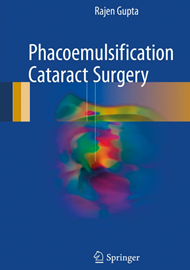The book, through a ‘rear-ended’ approach to training, covers basic and fundamental skills for the novice ophthalmic surgeon embarking on phacoemulsification cataract surgery. As the preface states, this is a ‘key surgical technique for an ophthalmologist to learn’. However, achieving a safe, efficient and successful outcome takes practice and opportunities to acquire the skills in a graded format can be difficult, particularly with overwhelming service demands. This can present a stressful ordeal for the trainee, trainer, theatre staff and the patient.
This manual has been adapted from a series of handouts developed by the author over years of experience supervising the novice surgeon, and the simple and clear style provides a framework for ‘bite-size surgical learning points’. As it is assumed that implants of multifocal, toric or anterior chamber lenses are unlikely to be encountered in the early stages of training, descriptions are confined to monofocal, single piece intraocular lens (IOL) insertion.
Divided into 15 chapters, the first chapter explains the phacoemulsification surgical learning process, describes how the theatre training time can be optimised and how modular training is used to develop the confidence of the trainee surgeon. Subsequent chapters show how ‘rear-end’ modular training can be organised into irrigation / aspiration to maintain the anterior chamber and remove unwanted anterior chamber material, IOL insertion, soft lens material removal, manual capsulorhexis, hydrodissection, phacoemulsification and disassembly of the lens nucleus, paracentesis and main corneal incisions and, finally, the essential preparations in theatre.
The online version of each chapter has Electronic Supplementary Material including videos of the techniques described. Each concept is described in stages and the reader is encouraged to read through the whole of each chapter for a full understanding. Training tips for both the trainer and trainee are included in each chapter, presented in highlighted boxes.
There are numerous colour diagrams and images that are clearly labelled illustrating the appearance of the lens material as it is disassembled and removed, the foldable IOL as it is introduced and positioned and the instrumentation employed. Although there are typographical errors noted, they were minor and did not detract from the clear presentation style.
Highly recommended reading for the experienced ophthalmic surgeon supervising their junior colleagues training programme and for the novice surgeons’ under their mentorship. Specialist ophthalmic nurses and optometrists supporting cataract surgery clinics will also find it interesting, and hopefully, after reading this book they will better understand the terms referred to in clinical notes and the sequence of actions that they are likely to witness given opportunities to watch phacoemulsification cataract surgery. Based on value-for-money, ease of understanding, content and contribution to personal development this book certainly deserves to be rated as 5 out of 5.




